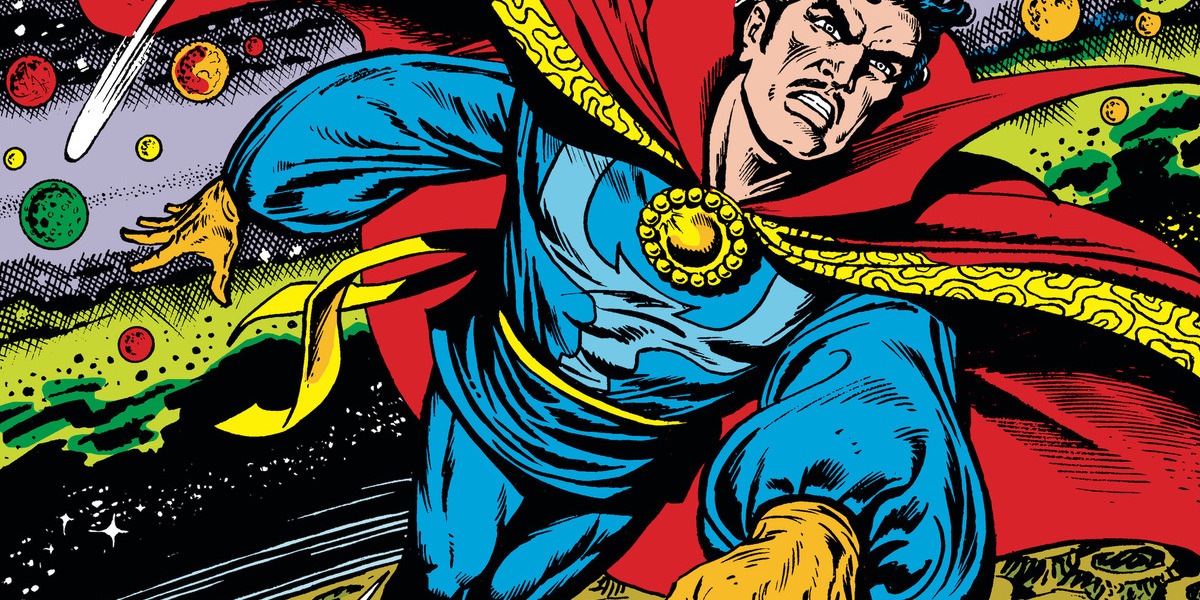
The Magic of Marvel: How We Met the Avengers, Doctor Strange, Daredevil and Others
Paul Cornell, Stuart Moore and Chris Ryall Discuss How They Discovered Their Love For Marvel Comics
If there’s one thing comic book fans enjoy, it’s discussing their favorite characters and stories with anyone who will listen (or read), debating the finer points of the stories and the art, and speculating about what comics or creators might have influenced these storylines, and all the other finer points that are worthy of debate. So it’s safe to say that all of us who were invited to pitch ideas for Bloomsbury’s new Marvel Age of Comics series have been training for this for most of our lives.
Stuart Moore was introduced to Doctor Strange when he was 16. He writes in Doctor Strange: A Decade of Dark Magic, “That summer, poring through [my friend’s] cosmic collection, led me to a lifetime of wonder…Maybe you’ve got a friend like him, someone who introduced you to an enduring passion at a critical time in your life. And maybe—just maybe—that passion is Marvel comics.”
*
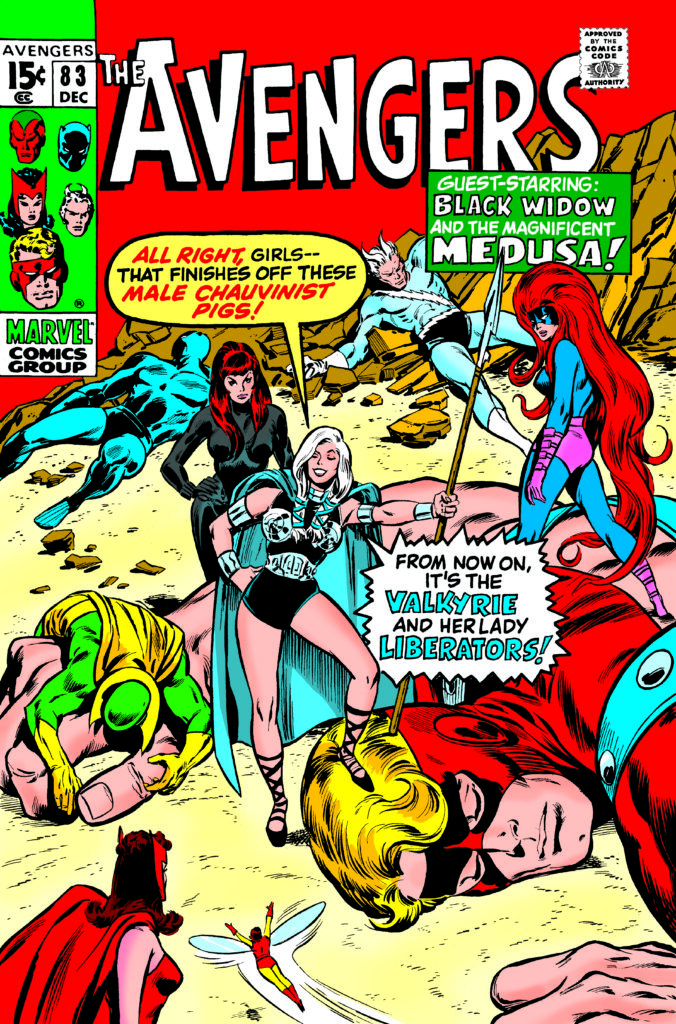 Cover of Avengers #83. Credit: John Buscema/Tom Palmer/Morrie Kuramoto. © 2025 MARVEL.
Cover of Avengers #83. Credit: John Buscema/Tom Palmer/Morrie Kuramoto. © 2025 MARVEL.
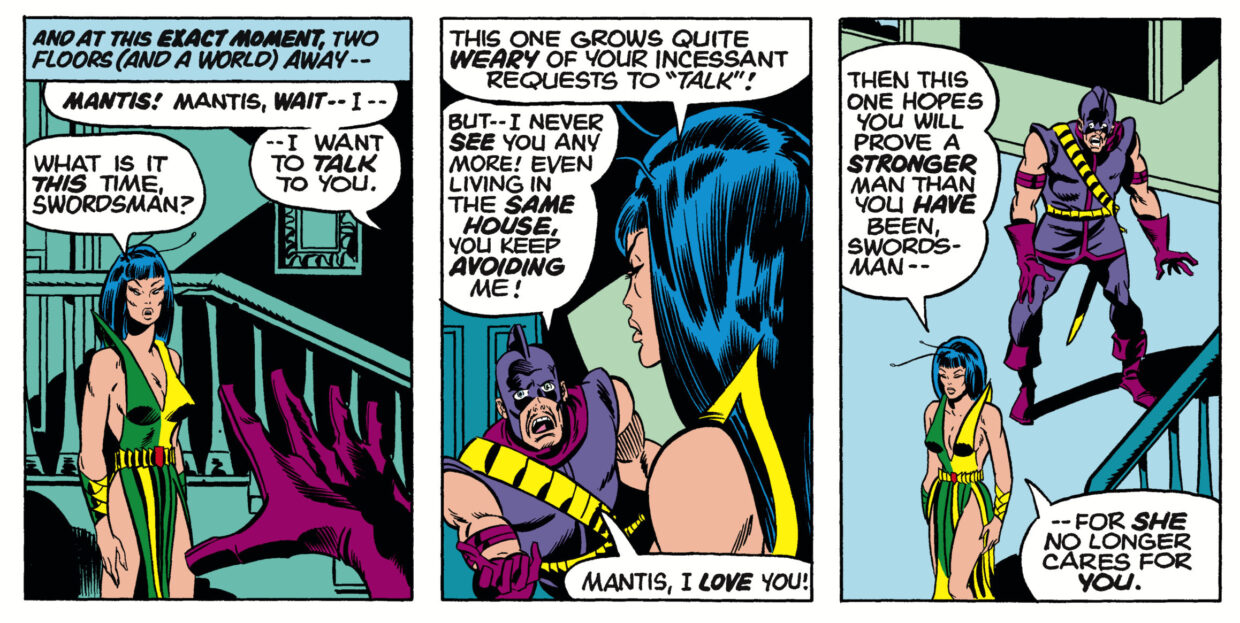 Avengers #128, Page 11. Panels 5-7. Credit Sal Buscema/Joe Staton. © 2025 MARVEL.
Avengers #128, Page 11. Panels 5-7. Credit Sal Buscema/Joe Staton. © 2025 MARVEL.
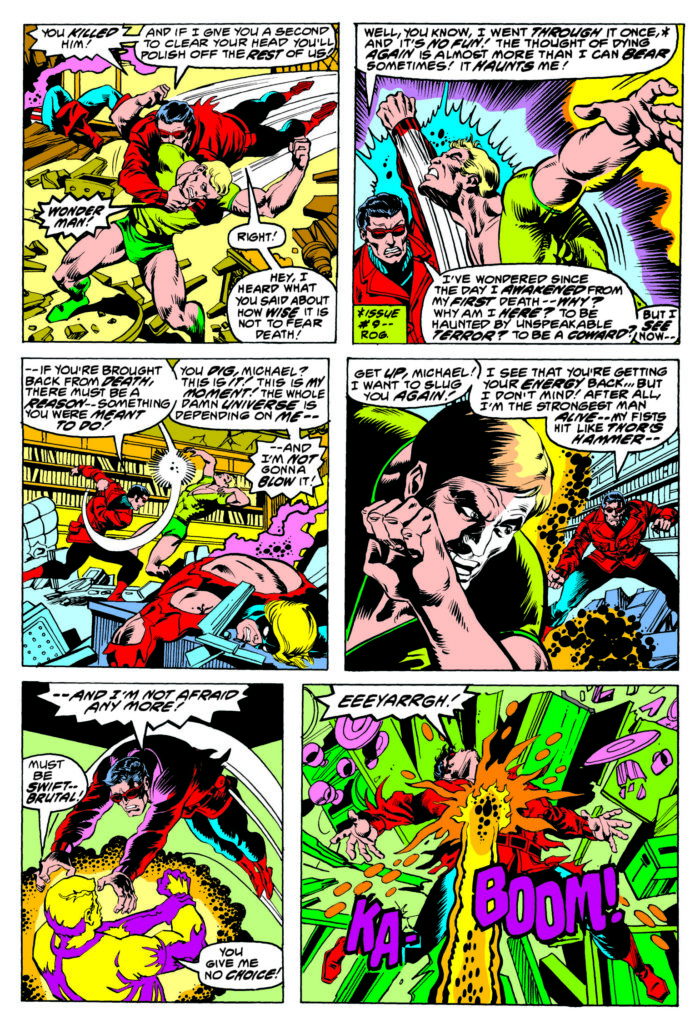 Avengers #177, Page 11. Credit: Dave Wenzel/Pablo Marcos/Ricardo Villamonte/Nel Yomtov. © 2025 MARVEL.
Avengers #177, Page 11. Credit: Dave Wenzel/Pablo Marcos/Ricardo Villamonte/Nel Yomtov. © 2025 MARVEL.
 Avengers #149, Page 5. Panels 7-8. Credit George Pérez/Sam Grainger/Hugh Paley. © 2025 MARVEL.
Avengers #149, Page 5. Panels 7-8. Credit George Pérez/Sam Grainger/Hugh Paley. © 2025 MARVEL.
*
When did you first get into comics and what did they mean to you then? How has that changed?
Chris Ryall: I was maybe five years old when I started, but I had a brother four years older who already had a decent comic collection. And he had older friends (nine or ten at least!), one of whom had an old copy of Fantastic Four #130 on his floor, and it utterly grabbed me—it was a Jim Steranko image of the Fantastic Four fighting the Frightful Four, and the mix of colorful characters and strangeness on display (a guy made of rocks fighting a guy made of sand! A woman with what looked like impossibly long and living hair! A guy flying around while lit on fire, someone else stretching across the cover…it was all utterly captivating to my young eyes) took hold of me then and hasn’t let go yet.
It’s certainly harder now, after working in the business and meeting and knowing so many people who make comics from all sides, to read them today with anything close to the purity they had when I was a kid, but that’s the thing we’re all still chasing, I think. Trying to discover exciting new talents and titles when we’re reading, and trying to create exciting moments that might equal that childhood burst of passion for someone else. Much has changed about comic books as an industry but the one thing that hasn’t is my love for the medium of comics and the people who make them.
I love the way a writer leaning into what an artist does can transcend both of them to make something greater.
Stuart Moore: Most people I know have a very firm childhood connection to either DC or Marvel. I mostly read DC as a young kid—but when I was sixteen, a friend introduced me to Marvel, which at the time was experimenting in all sorts of mind-blowing directions. So to me, DC is a warm feeling in my heart and Marvel is the exciting stuff, the thrill of realizing there’s so much more out there.
I should add that I’ve since worked with both companies in several capacities, and they’ve each published ground-breaking and medium-expanding work. The industry is always changing.
Paul Cornell: Thanks to my Dad, comics have been in my life for as long as I can remember. He used to pick things off the newsagent’s shelf and bring them home, notably Avengers Weekly, which ran Avengers from #4, with Dr. Strange in the back, in black and white. I think the immediacy of the form has always felt special to me, which is rooted in Stan Lee’s extraordinary ability to address the child reader directly. They’ve always been there to make me feel understood and supported, particularly, like so many, with Chris Claremont’s X-Men. These days that’s sometimes become “a friend wrote this,” which is a lucky place to be.
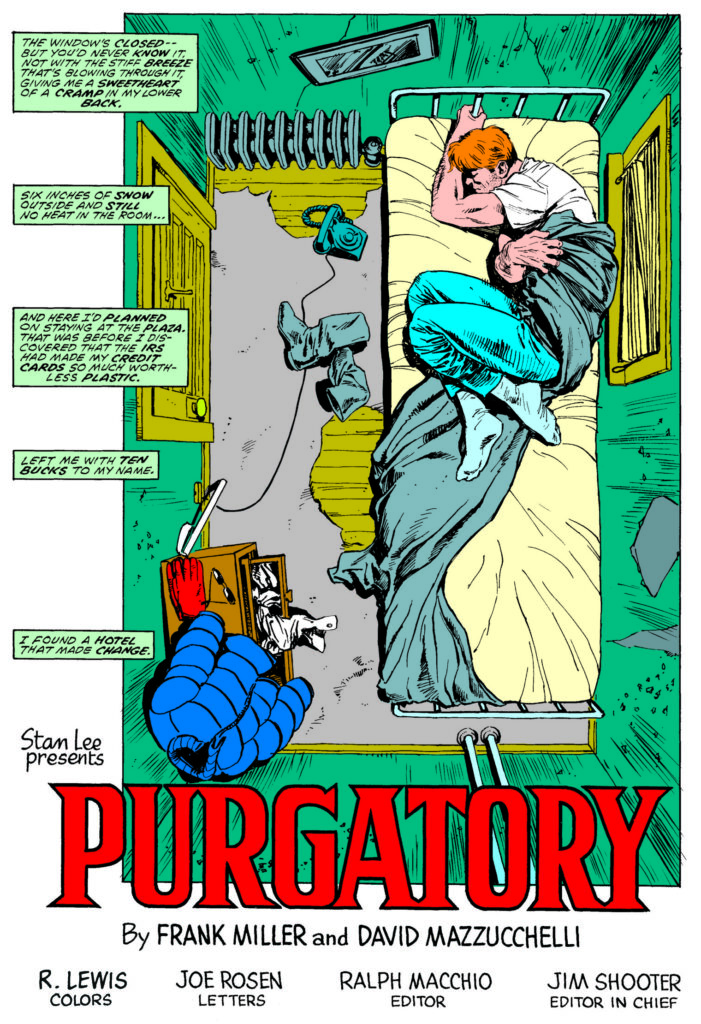 Daredevil #228 page 2 © 2025 MARVEL.
Daredevil #228 page 2 © 2025 MARVEL.
 Daredevil #227 page 4 © 2025 MARVEL.
Daredevil #227 page 4 © 2025 MARVEL.
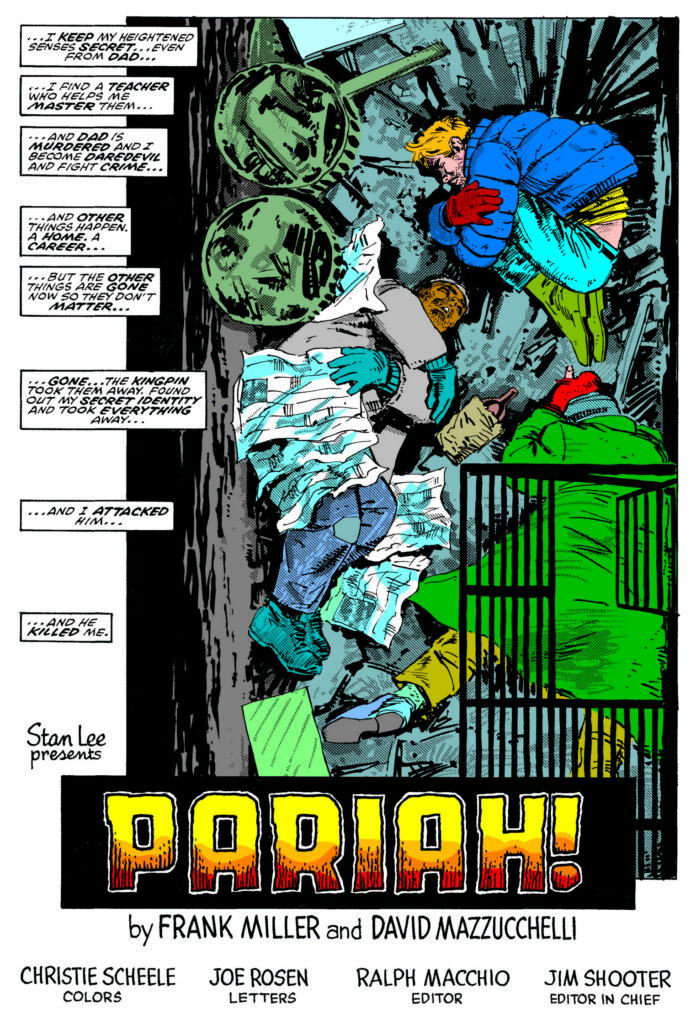 Daredevil #229 page 6 © 2025 MARVEL.
Daredevil #229 page 6 © 2025 MARVEL.
*
Are there any standout moments that you come back to from time to time?
PC: Wolverine rid himself of the Brood infection at a particularly tough time in my life. Logan’s ability to remain himself, and not express his enormous PTSD by taking up any sort of crusade or wish to harm others, has been very important to me. I’ve identified with many comics in the following decades, Kieron Gillen and Gail Simone being particularly good at expressing bits of me that felt underexplored.
SM: I think Steve Gerber’s Howard the Duck got me through age fifteen.
CR: As much as I aim to keep a strong foothold in what’s new, sure, it’s still fun to revisit the things I loved as a kid, too, in the same way it’s comforting to re-watch an old movie. Not only does it return me to a time when I had nothing but pure enjoyment of comics—I didn’t know how they were made, had not with very few exceptions met the people who made them, I just enjoyed the stories and art—but now I also try to dissect what it is about certain comics or creators that has lodged their work so firmly inside my head. And I study them to see if there are ways to simulate or approximate—distill, really—the magic they put into those comics. Of course, much of that magic comes from when you first read them, and that’s something out of our control. But yes—I revisit the works of John Byrne, Frank Miller, Alan Moore, Walter Simonson, Moebius, the EC Comics that long predate my time reading comics or on this planet but still work their spell on me, and on and on.
Comics when viewed through a similar historical lens can also say so much more about the world and the comics’ creators.
As I’ve been trying to pare down the comics I’ve amassed over the decades, I find that the ones I want to hang onto aren’t the ones with the most value but are instead the things I loved when I was ten.
 Marvel Premiere (1972) #9, July 1973, page 1. Story by Steve Englehart, art by Frank Brunner and Ernie Chua. © 2025 MARVEL.
Marvel Premiere (1972) #9, July 1973, page 1. Story by Steve Englehart, art by Frank Brunner and Ernie Chua. © 2025 MARVEL.
 Strange Tales (1951) #146, July 1966, page 5. Story by Dennis O’Neil, art by Steve Ditko. © 2025 MARVEL.
Strange Tales (1951) #146, July 1966, page 5. Story by Dennis O’Neil, art by Steve Ditko. © 2025 MARVEL.
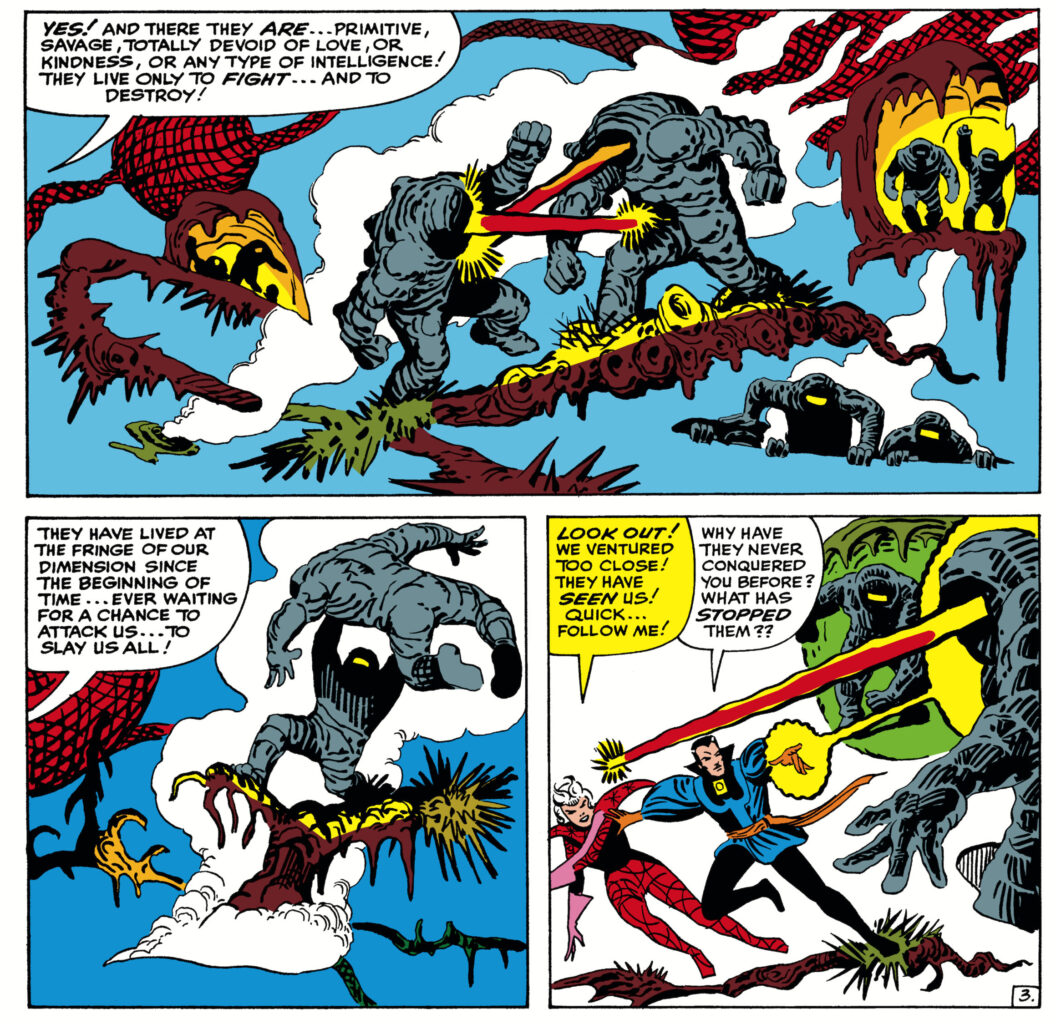 Strange Tales (1951) #127, December 1964, page 3. Panels 3-5. Story by Stan Lee, art by Steve Ditko. © 2025 MARVEL.
Strange Tales (1951) #127, December 1964, page 3. Panels 3-5. Story by Stan Lee, art by Steve Ditko. © 2025 MARVEL.
*
What makes comics most exciting to you—the stories, the art, the plotlines and messaging they choose, the artistic pairings, how they reflect culture?
PC: I love the way a writer leaning into what an artist does can transcend both of them to make something greater.
SM: All of that, yes. I chose to write about Doctor Strange in large part because of the character’s strong links to New York City, where I’ve chosen to live, and in particular to the East Village. The Marvel comics of the 1960s were firmly set in New York; Stan Lee and his collaborators clearly felt the influence of the changing urban environment, at the same time their work became a vital force in the evolving counterculture. When you look back at it, you can see it was all part of a fast-moving, surging cultural tide.
CR: All of it; all of those things and more. Comics are one of the great art forms, there’s such an arcane wizardry in the way static images blend with word balloons, thought balloons, captions, sound effects, the way our eyes and brain fill on the empty space between the panels as we go, and the way those panels (if the comic is done well) build on each other and keep propelling you from one to the next to the next, and keep you furiously turning pages to see what’s going to happen. The way we can absorb all of those parts and consume them at the speed comfortable to each of us, rather than being forced to watch a movie or listen to a song at the speed someone else decided was best.
The way comics reflect the culture or the era in which they’re made is another fascinating thing, and it’s one of the key elements that makes all of these Bloomsbury books interesting to me, in much the same way the 33 1/3 books or their film books do. I mean, it’s one thing to listen to James Brown’s “Live at the Apollo” and be taken in by the power and energy of the songs and the people performing them, but that record takes on so much more weight and importance when you consider the setting and time period in which it was made. Likewise, comics when viewed through a similar historical lens can also say so much more about the world and the comics’ creators, especially when you take into consideration the way past storylines, real and fictional, keep echoing and repeating throughout our history.
__________________________________
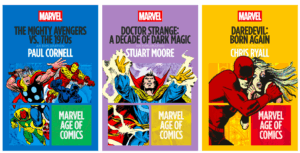
The Mighty Avengers vs. the 1970s by Paul Cornell. Copyright © 2025 MARVEL. Available from Bloomsbury Academic.Doctor Strange: A Decade of Dark Magic by Stuart Moore. Copyright © 2025 MARVEL. Available from Bloomsbury Academic.Daredevil: Born Again by Chris Ryall. Copyright © 2025 MARVEL. Available from Bloomsbury Academic.
Paul Cornell, Stuart Moore and Chris Ryall
Paul Cornell (The Mighty Avengers vs. The 1970s) has written episodes of Elementary, Doctor Who, Primeval, Robin Hood and many other TV series. He has worked for every major comics company on series such as I Walk with Monsters, The Modern Frankenstein, Saucer Country, and This Damned Band, as well as runs for Marvel and DC on Batman and Robin, Wolverine and Young Avengers. He is based in the UK.
Stuart Moore (Doctor Strange: A Decade of Dark Magic) is a Brooklyn-based writer, book editor, and award-winning comics editor. His recent Marvel projects include Captain America for Dummies and the novel Into the Dark Dimension. He has also co-written three volumes of the New York Times bestselling series The Zodiac Legacy with Stan Lee, as well as prose and comics set in the universes of Marvel, DC Comics, Stargate, The Transformers, Conan the Barbarian, Redwall, and Star Trek.
Chris Ryall (Daredevil: Born Again) boasts a prolific career in comics as writer, editor, publisher, and historian. Currently the co-founder of Image Comics, Syzygy Publishing, and Editor-at-Large at Abrams ComicArts, Ryall is also the former Chief Creative Officer at IDW Publishing. His co-creations include of Zombies vs Robots, Onyx, Groom Lake, The Hollows, and Dreamweaver. He was an executive producer on Netflix’s Locke & Key. His most recent releases include The Mighty Marvel Calendar Book, Origins of Marvel Comics: The Deluxe Edition, and Dread the Halls. Other 2025 releases include the graphic novel Megalopolis with co-writer Francis Ford Coppola and Son of Origins of Marvel Comics: The Deluxe Edition.












